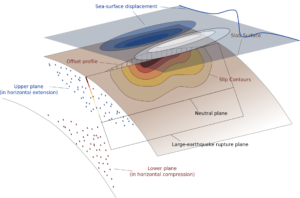Earthquake and tsunami hazard from outer rise faults
As oceanic plates enter a subduction zone and begin their descent into Earths’ interior, they bend. This bending creates fractures and faults in the down-going plate, producing earthquakes. These earthquakes typically show a pattern of shallow normal-faulting earthquakes and deeper thrust-faulting earthquakes, and can be very large; the largest normal-faulting event ever recorded is the 1977 M8.3 Sumba earthquake along the Indonesian subduction zone. As these earthquakes occur underwater, they have the potential to generate devastating tsunamis. In this project, you will produce quantitative estimates for the hazard posed by such earthquakes that can be used to prepare regions for tsunami disasters.
Where a down-going slab starts to subduct, it starts to bend, uplift (producing an outer rise), and deform internally to accommodate the change in shape necessary for it to descend into the Earths Interior. This bending of the plate is accompanied by active fracturing faulting, particularly in the upper-most sections of the plate where bending causes the plate to stretch. These near-surface extensional faults typically grow larger the closer they get to the subduction trench, and in some cases (e.g., Japan, Tonga), can accumulate kilometre-scale displacements, and can reach lengths of ~100 km.
Although earthquakes along outer-rise faults are relatively rare, and typically occur soon after major earthquake events on the adjacent subduction interface, they can be very large and may reach mid M8. Earthquakes on these outer-rise faults have notable displacement patterns, with the highest slip commonly being on the outer surface of the bending plate (i.e. the seabed). By rapidly offsetting the seabed, these outer-rise earthquakes can displace the water column and create powerful tsunamis, which can lead to the inundation of nearby coastal regions.
Despite a broad recognition of the tsunami hazards posed by outer-rise earthquakes, we know very little about the specific details of what controls the capacity for outer rise earthquakes in a given region to generate major tsunamis. To help understand this problem, the project will consist of three main avenues of enquiry:
- In the first, you will map the distribution of faults in outer rise regions using marine geophysical data.
- In the second, you will study the population, distribution, and slip distributions of observed outer rise earthquakes and relate these to the fault networks identified in (1).
- You will then integrate observations these to construct theoretical models for the strain accommodation in the outer rise, how this produces populations of earthquakes, and the slip characteristics of those earthquakes.
- In the final stage of the project, you will build informed scenarios for potential major outer rise earthquakes in areas of interest, and model the subsequent tsunami propagation and inundation, considering the potential hazard posed to nearby regions.

Figure 1: (a) Sketch illustrating the slip and tsunami generation of earthquakes in the bending region of the Outer Rise.
References:
- Baba et al., (2022).Deep investigations of outer-rise tsunami characteristics using well-mapped normal faults along the Japan trench, Journal of Geophysical Research, v125, doi:10.1029/2020JB020060.
- Craig et al., (2014).A reassessment of outer-rise seismicity and its implications for the mechanics of oceanic lithosphere, Geophysical Journal International, v197, doi:10.1093/gji.ggu013.
- Lay et al., (2009).The 2006-2007 Kuril Islands great earthquake sequence, Journal of Geophysical Research, v114, doi:10.1029/2008JB006280.
- Álvarez-Gómez et al., (2012).Tsunamigenic potential of outer-rise normal faults at the Middle America trench in Central America, Tectonophysics, v574, doi:10.1016/j.tecto.2012.08.014.
- Sugawara (2021).Numerical modeling of tsunami: advances and future challenges after the 2011 Tohoku earthquake and tsunami. Earth Sci. Rev., v214, p. 103498
Objectives:
You will work to understand the seismic potential of outer rise regions, constructing maps of outer rise fault networks, magnitude-frequency populations, and realistic slip scenarios for major outer rise earthquakes. You will then target several potential areas susceptible to major outer rise earthquakes, and quantify the hazard these pose to nearby populated regions using a deterministic approach to both seismic hazard, and tsunami generation.
Applicant Background:
This project would suit candidates with a background in quantitative geology, geophysics, or physics with an interest in solid-Earth processes. Prior skills in coding are desirable, but not required. We encourage applicants from all backgrounds.
Training:
The student will be based the Institute for Geophysics and Tectonics at the University of Leeds. The student will receive training in observational earthquake seismology, marine geophysics, numerical geodynamics and tsunami modelling. They will also receive additional training through the Doctoral Training program hosted by the Faculty of Environment and the University of Leeds and the Doctoral Training Partnership. Within Leeds, they will have the opportunity to interact with the internationally-excellent research group in Tectonics, hosted within the Institute for Geophysics and Tectonics. The School also hosts numerous staff from the NERC-funded Centre for the Observation and Modelling of Earthquakes and Tectonics (www.comet.nerc.ac.uk), with whom the student will be able to interact. The Department of Environment and Geography at the University of York, offers an outstanding and multidisciplinary environment in which to carry out PhD research. Our current students come from many countries around the world and are well supported by a comprehensive programme of training and an inclusive supervision network. The Department also hosts the York centre of the Stockholm Environment Institute, the independent, international research organisation committed to the implementation of practices supportive of global sustainable development.
